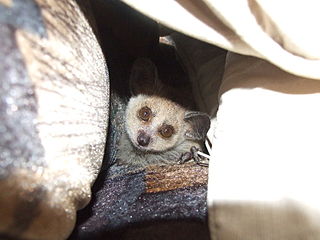
Galagos, also known as bush babies or nagapies, are small nocturnal primates native to continental, sub-Sahara Africa, and make up the family Galagidae. They are considered a sister group of the Lorisidae.

Lesser bushbabies, or lesser galagos, are strepsirrhine primates of the genus Galago. They are classified, along with the other bushbaby and galago genera in the family Galagidae. They are probably the most numerous primate in Africa, and can be found in every large forest on the continent, inhabiting forested areas, savannas, riverine bush and open woodlands.

The brown greater galago, also known as the large-eared greater galago or thick-tailed galago, is a nocturnal primate, the largest in the family of galagos. As opposed to smaller galago species it would climb, walk or run rather than leap.
The montane hylomyscus or montane wood mouse is a species of rodent in the family Muridae. A long-coated species with brownish-grey upper parts and whitish-grey underparts, it occurs in the uplands of tropical Central Africa where its natural habitat is tropical moist montane forests.

The crested mona monkey, also known as the crowned guenon, crowned monkey, golden-bellied guenon, or golden-bellied monkey,, is a species of African primate in the family Cercopithecidae found in west central Africa.

The southern needle-clawed bushbaby is a species of strepsirrhine primate in the family Galagidae. Found in Cameroon, Central African Republic, Republic of the Congo, and possibly Democratic Republic of the Congo, its natural habitat is tropical moist forests. While the species is not threatened or endangered, some local populations may be threatened by habitat destruction.

The northern needle-clawed bushbaby is a species of strepsirrhine primate in the family Galagidae. It is found in the coastal region of Cameroon and Nigeria, and on the island of Bioko, Equatorial Guinea in lower-elevation forests that provide its specialized diet of tree gum and resins.

Bioko Allen's bushbaby, also known as the Bioko squirrel galago, is a species of primate in the galago family found in Cameroon, Nigeria, and the island of Bioko, Equatorial Guinea. Its natural habitat is subtropical or tropical dry forests. The bushbaby is currently near-threatened, according to the International Union for Conservation of Nature.

Grant's bushbaby, also known as Grant's lesser bushbaby or the Mozambique lesser bushbaby, is a species of primate in the family Galagidae. It is found in Malawi, Mozambique, Tanzania, and Zimbabwe. Its natural habitat is subtropical or tropical dry forests. It is a common species and the International Union for Conservation of Nature has assessed its conservation status as being of "least concern".

The dusky bushbaby is a species of primate in the family Galagidae. It is also known as Matschie's galago, in honour of the German zoologist Paul Matschie, curator of mammals at the Museum für Naturkunde in Berlin. Native to tropical Central Africa, it is found in forests in Burundi, Rwanda, Democratic Republic of the Congo and Uganda. The species is small with a long tail, and has an arboreal, nocturnal and omnivorous lifestyle.

The Mohol bushbaby is a species of primate in the family Galagidae which is native to mesic woodlands of southern Africa. It is physically very similar to the Senegal bushbaby, and was formerly considered to be its southern variety. The two species differ markedly in their biology however, and no hybrids have been recorded in captivity.
Thomas's rope squirrel or redless tree squirrel is a species of rodent in the family Sciuridae. It is found in Benin, Cameroon, Central African Republic, Democratic Republic of the Congo, Equatorial Guinea, Gabon, and Nigeria. Its natural habitat is subtropical or tropical moist lowland forests. It is a common species and the International Union for Conservation of Nature has rated it as being of "least concern".

The Lady Burton's rope squirrel is a species of rodent in the family Sciuridae. It is found in Cameroon, Central African Republic, Republic of the Congo, Equatorial Guinea, and Gabon. Its natural habitats are tropical and subtropical moist broadleaf forests and subtropical or tropical moist montane forest. It is a common species with a wide range, and the International Union for Conservation of Nature has rated it as being of "least concern".

The Zanj sun squirrel is a species of rodent in the family Sciuridae found in eastern Africa.

The Gabon bushbaby is a species of primate in the family Galagidae found in Cameroon, Gabon, and the Republic of the Congo. Its head and body length is 8.5 in with a 10-in tail, and it weighs about 10 oz. It lives in evergreen tropical rainforests and eats primarily fallen fruit, but also some arthropods.

The Osman Hill's mangabey, also known as the rusty-mantled mangabey, is a subspecies of the grey-cheeked mangabey, a crested mangabey in the family Cercopithecidae, with a restricted distribution in West Africa.

The squirrel galagos are a group of four species of strepsirrhine primates. They are classified in the genus Sciurocheirus of the family Galagidae.















